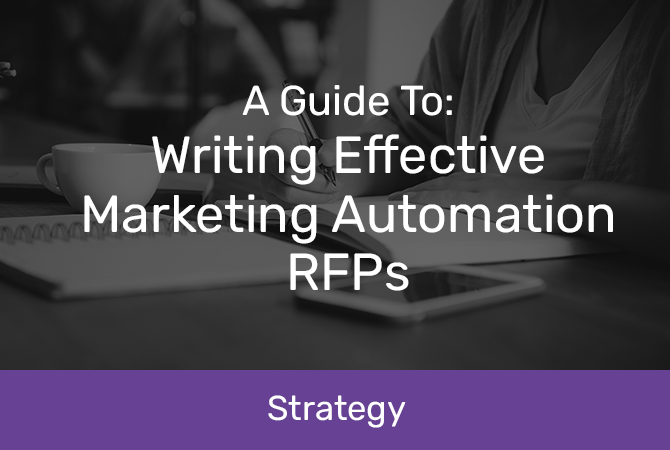
A Guide to Writing Effective Marketing Automation RFPs
Actionable steps from an experienced marketing automation provider
This article will guide you through the RFP process when selecting a marketing automation provider, including actionable steps to ensure you join forces with the right one.
the basics - what is an rfp?
A traditional RFP is a ‘request for proposal’, a document used by large enterprises to outline the requirements for a specific project and solicit bids from agencies or companies interested in procuring a product or service.
What is a Marketing Automation RFP?
In the context of marketing automation, you would use an RFP to find a software provider that could help your marketing team work smarter, faster and more efficiently – and, ultimately, drive better results.
You might use a marketing automation RFP to find and implement the following:
-
An email automation tool that tracks the performance of your email marketing campaigns
-
A social media automation tool that makes it easier to create and post content across multiple social media channels
-
A system that optimises the launch, coordination and analysis of targeted digital advertising – for example, contextual advertising on a search engine
-
An automation tool for transitioning website traffic to your CRM, or that helps convert new leads in the sales funnel into paying customers through email, chatbots and instant messages.
-
A tool that collects, controls and analyses reporting metrics from various marketing channels to help you find the most effective techniques and tools.
RFP versus RFQ
While an RFP includes a price quote (along with several other specifics), an RFQ or ‘request for quote’ doesn’t detail anything other than price. In most cases, an RFP is more than comparing quotes to see if a potential vendor is the right fit for your organisation.
IS AN RFP WORTH YOUR TIME? 
Choosing the RFP Path
Whether to use the RFP procurement process or skip it and conduct research to identify a suitable vendor, comes down to what best suits your organisation.
The RFP process has several benefits:
-
There’s less chance of bias – all vendors have access to the same information.
-
A focus on specific criteria – stops you from evaluating a vendor based on information that isn’t necessarily relevant to the RFP’s criteria.
-
Discover new vendors – signing an agreement with a current vendor is faster, but the RFP process might shine a light on a new and better-suited vendor.
But there are also some drawbacks:
-
The process can be lengthy and expensive, which could put off potentially good vendors.
-
It’s also a more formal and strict way of evaluating vendors, which leaves little room for relationship-building or other benefits outside of the RFP that could prove valuable.
Many companies find an RFP takes time upfront, but it’s worth the legwork in the long run:
-
You’ll save time – you can write one RFP and send it to multiple vendors.
-
You can cast a wider net – rather than relying on recommendations from your immediate network.
-
You can quickly weed out any bad apples – an RFP gives you a sneak peek into each vendor’s confirmed plan of action, rather than the one they talk you into over the phone or in person.
-
You can uncover areas and features you might not have considered and compare capability side by side.
However, a non-RFP process has its place and could be the right call for your organisation.
Here are some of the pros and cons of a non-RFP process:
-
You can choose the vendors you want to consider, but this can also mean previous relationships with certain vendors could influence your decision.
-
Vendors can include additional functionality or values-based information that usually sit outside the RFP process, which can be beneficial if you’re looking for a vendor that is both a company fit and a technical fit.
-
However, a non-RFP process can also be prone to schedule delays and skipped steps which can muddy the project waters, making it more challenging to keep on track and budget.
Writing an RFP
The basic structure of a marketing automation RFP:
1. Project Overview
Your RFP must first explain why you’re requesting vendor proposals so vendors know immediately if the RFP is worth their time.
2. Your company background
Keep this short to give vendors a good idea of what your company does and the problem your product or service solves for your target market and industry.
3. Project goals
Identify what you want to accomplish and what you see as a ‘win’, addressing any KPIs. Clearly outline the current state of your marketing automation campaigns and the desired future state.
4. Project scope
A vague project scope won’t help you find the right vendor, so spend time detailing it to avoid any surprises later. It’s a good idea to provide a couple of use cases to give vendors more insight into how your team will use the platform and your current tech stack and user capabilities.
5. Timeline expectations
Vendors need to know if they have the resources and capacity to complete the job on time. Provide deadline expectations for RFP responses, in-person meetings and project turnaround times. Make sure they’re reasonable, especially if there are multiple people involved.
6. Any possible roadblocks
Don’t hide your existing or potential issues under the rug if you want them to disappear. A successful RFP is explicit about any technical problems or roadblocks to better connect with companies that know how to work around issues like custom coding, outdated platforms or limited team resources.
7. Any budget limitations
Be candid about your budget expectations to avoid financial speedbumps from the outset.
8. Vendor criteria
Working with a marketing automation platform should be a partnership where the platform is helping you meet a business need. But the RFP should also focus on the type of vendor and partner you want. For factors like cultural fit and values, proof of background and skills – here are some questions to consider:
-
What’s going to work for my company?
-
Is this vendor too advanced for what I need, or is it too far behind?
-
Will it grow with me? Does it have a good support team?
-
Is it on a growth trajectory?
Ask for a roadmap
You want to work with a marketing automation provider that’s happy to share its plans, to give you an idea of scalability and your future state. Ask about integration with other software, too – knowing how the platform will affect your overall tech stack can save you money in the long run.
What not to do with an RFP is to be vague.
Your RFP must be specific if you want to find the right vendor. Don’t ask ‘yes’ or ‘no’ questions. Instead, ask open-ended questions that require vendors to show their thinking when solving a problem.
For example – Can you share how you’ve solved this problem or a similar one for another company? Did you encounter any unexpected roadblocks, and how did you overcome them.
HOW PROVIDERS ANSWER RFPS
Once you send out your RFP, vendors can review it and submit their best bids, including:
- An action plan – how they’re going to solve the issue
- A project timeline – what you can expect and when
- Background information – about their company and where it’s headed
- Pricing – how much they expect the project to cost
Is your marketing automation not delivering?
Marketing automation gets messy. With an ocean of data, fighting to get different programs talking to one another, and trying to send the right message to the right people at the right time, it can feel impossible.
If you’d like to chat with experts who untangle marketing automation knots every day, get in touch. We’ll get back to you within one business day.















































